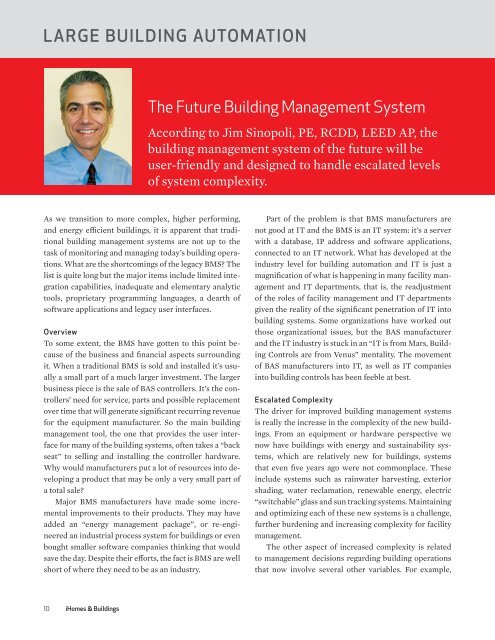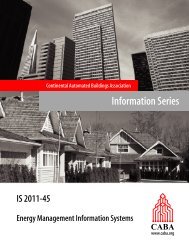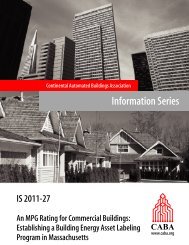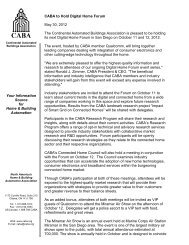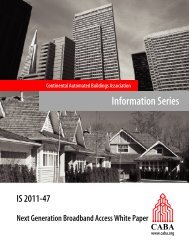The Future Building Management System - Continental Automated ...
The Future Building Management System - Continental Automated ...
The Future Building Management System - Continental Automated ...
You also want an ePaper? Increase the reach of your titles
YUMPU automatically turns print PDFs into web optimized ePapers that Google loves.
Large <strong>Building</strong> Automation<strong>The</strong> <strong>Future</strong> <strong>Building</strong> <strong>Management</strong> <strong>System</strong>According to Jim Sinopoli, PE, RCDD, LEED AP, thebuilding management system of the future will beuser-friendly and designed to handle escalated levelsof system complexity.As we transition to more complex, higher performing,and energy efficient buildings, it is apparent that traditionalbuilding management systems are not up to thetask of monitoring and managing today’s building operations.What are the shortcomings of the legacy BMS? <strong>The</strong>list is quite long but the major items include limited integrationcapabilities, inadequate and elementary analytictools, proprietary programming languages, a dearth ofsoftware applications and legacy user interfaces.OverviewTo some extent, the BMS have gotten to this point becauseof the business and financial aspects surroundingit. When a traditional BMS is sold and installed it’s usuallya small part of a much larger investment. <strong>The</strong> largerbusiness piece is the sale of BAS controllers. It’s the controllers’need for service, parts and possible replacementover time that will generate significant recurring revenuefor the equipment manufacturer. So the main buildingmanagement tool, the one that provides the user interfacefor many of the building systems, often takes a “backseat” to selling and installing the controller hardware.Why would manufacturers put a lot of resources into developinga product that may be only a very small part ofa total sale?Major BMS manufacturers have made some incrementalimprovements to their products. <strong>The</strong>y may haveadded an “energy management package”, or re-engineeredan industrial process system for buildings or evenbought smaller software companies thinking that wouldsave the day. Despite their efforts, the fact is BMS are wellshort of where they need to be as an industry.Part of the problem is that BMS manufacturers arenot good at IT and the BMS is an IT system: it’s a serverwith a database, IP address and software applications,connected to an IT network. What has developed at theindustry level for building automation and IT is just amagnification of what is happening in many facility managementand IT departments, that is, the readjustmentof the roles of facility management and IT departmentsgiven the reality of the significant penetration of IT intobuilding systems. Some organizations have worked outthose organizational issues, but the BAS manufacturerand the IT industry is stuck in an “IT is from Mars, <strong>Building</strong>Controls are from Venus” mentality. <strong>The</strong> movementof BAS manufacturers into IT, as well as IT companiesinto building controls has been feeble at best.Escalated Complexity<strong>The</strong> driver for improved building management systemsis really the increase in the complexity of the new buildings.From an equipment or hardware perspective wenow have buildings with energy and sustainability systems,which are relatively new for buildings, systemsthat even five years ago were not commonplace. <strong>The</strong>seinclude systems such as rainwater harvesting, exteriorshading, water reclamation, renewable energy, electric“switchable” glass and sun tracking systems. Maintainingand optimizing each of these new systems is a challenge,further burdening and increasing complexity for facilitymanagement.<strong>The</strong> other aspect of increased complexity is relatedto management decisions regarding building operationsthat now involve several other variables. For example,10 iHomes & <strong>Building</strong>s


